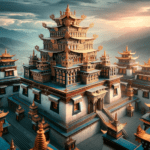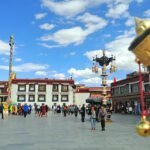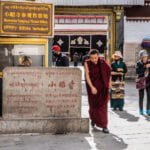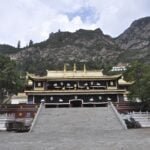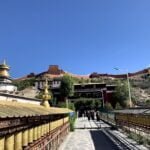Drachi Temple is a unique and spiritually significant temple, north of Lhasa, near Sera Monastery.
Details about Drachi Temple:
Drachi Temple was founded during the Qianlong period of the Qing Dynasty by Jampa Milam. Initially, it was named “Drachi Gomba” or the “Four Lamasery” because it housed only four monks when it was first established. The temple complex occupies a relatively small area and consists of a main hall that rises three stories high. The first floor of the main hall serves as a place of worship and enshrines various deities, including Guhyasya Vajra, Majesty Vajra, Chakrasamvara, Kalachakra Vajra, Amitayus Buddha, King of Heavenly Knowledge, Six-Armed Lord, Zhaji Earth God, and others.
Climbing to the third floor of the main hall, visitors can find statues and representations of various Buddhist figures, including Sakyamuni Buddha, Past Buddha, Infinite Life Buddha, Holy Avalokitesvara, Tara, Padmasambhava, and more. The temple complex also honours figures like Drom Tonpa, Master Atisha, Master Tsongkhapa, and the founder of Tibetan opera, Tangtong Gyalpo.
Goddess Drachi Lhamo:
Drapchi Temple features a distinctive image of the goddess Drapchi Lhamo, uniquely depicting her with chicken feet and a long, protruding tongue. This imagery represents her extraordinary transformation from the demon world to the divine world, emphasizing her extraordinary powers. Believers highly venerate Drapchi Lhamo for her protective role.
Drapchi Temple stands out as Tibet’s only temple dedicated to wealth. Despite its small size, it boasts a vibrant incense culture. Devotees visit the temple on specific days to pray for blessings such as wealth, peace, and health. The God of Wealth receives strong liquor offerings, especially from those seeking his blessings.
Cross-Cultural Worship:
Drachi Temple, unlike many other monasteries in Tibet, draws worshipers from the mainland, particularly Han people. Han businessmen in Lhasa and long-distance bus drivers often visit the temple to offer incense and seek blessings.
The temple is famous for its divination skills. In the main hall on the third floor, a statue of the Auspicious God and a prophecy tube are housed. Devotees silently pray and shake out a prophecy, which an eminent monk then interprets. This divination practice is well-regarded for its effectiveness.
Goddess Drachi Lhamo, known for her distinctive appearance and protective role, stands as a central figure in the temple’s history and beliefs. According to legend, she flies around the world daily for three weeks, dispelling demons and safeguarding peace, symbolizing the temple’s spiritual significance and unique character.
Drachi Lhamo: Young Mistress of the Qing Dynasty
During the Qing Dynasty, Emperor Qianlong cherished one of his youngest concubines, known for her youth, beauty, and kindness. She often accompanied the Emperor as his constant companion. (This concubine was different from the one who stayed by the shore of Daming Lake.)
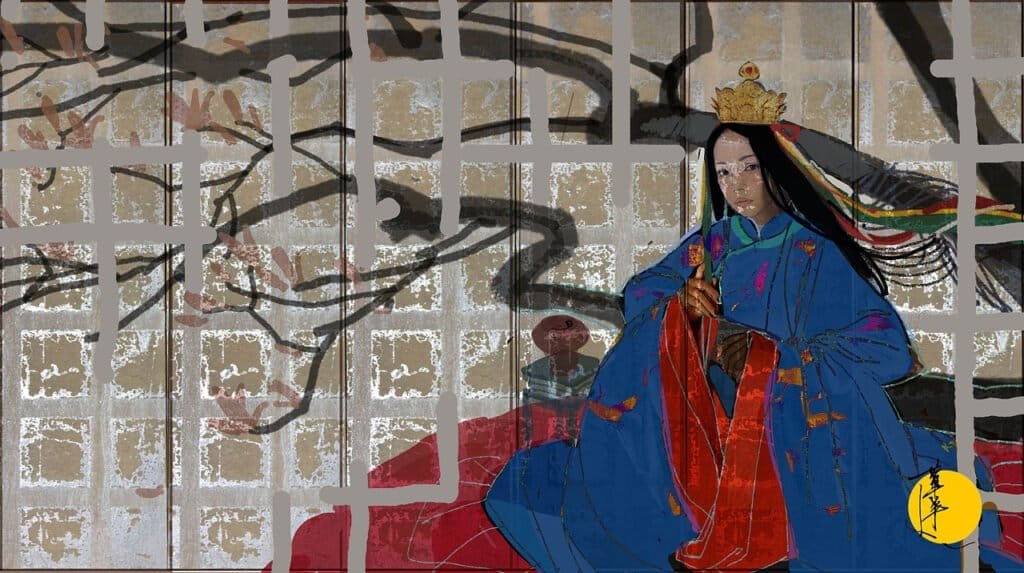
However, the eldest concubine was jealous and resentful of the young concubine’s favour with the emperor. She falsely accused the young concubine of a crime and had her thrown into prison. She even attempted to poison her, but the poison did not work, causing the young concubine’s tongue to turn black and forcing her to spit it out, which led to her death.
Spirit of Young Princess: Drachi Lhamo
The other concubines feared that the young concubine would reveal their involvement in her death, so they cut off her feet and left her to die alone. The young concubine’s spirit was unable to find peace due to the injustice done to her. She became a vengeful ghost and appeared near the palace every night, causing fear and panic among the people.
To resolve this issue, Emperor Qianlong called upon Tibetan Buddhist monks to come to Fuyao and conduct a longevity ritual for the emperor. Sera Temple’s Je Dratsang Khenbo Jampa Minlam was invited to attend.
Upon arriving in Beijing, the master offered a prayer and blessing to the female ghost, which forced her to appear and kneel. The ghost revealed that she was unjustly imprisoned and poisoned to death. Feeling compassion, the master follows the ritual to calm the resentment of the angry spirit. The young concubine requested the master to come together to Tibet.
Young Princess with Chicken Legs
However, the journey to Tibet is so distant that the young mistress cannot make it on foot. While passing through a vegetable market, the elder monk procured two chicken legs for her and they continued their journey to Tibet together.
Upon arrival in Lhasa, they found that the golden roof of the Sera Temple was not a fitting place for the young mistress’s soul. With the permission of the local master Sajong, they settled in the Drapchi temple and became guardians of the local people, receiving support from the community.
Presently, Drapchi Lhamo sticks out his tongue and has two chicken feet.
Rituals in Drachi Temple
Drapchi Temple, a dependent temple of Sera Monastery, has its monk appointments overseen by Sera Monastery. The temple hall’s central focus includes statues of Guru Rinpoche, Yamantaka, and other Great Tibetan Buddhist masters. Unique to Drapchi Temple, statues of Drachi Lhamo and the Guardian Kings, positioned on either side of the entrance, receive worship from visitors.
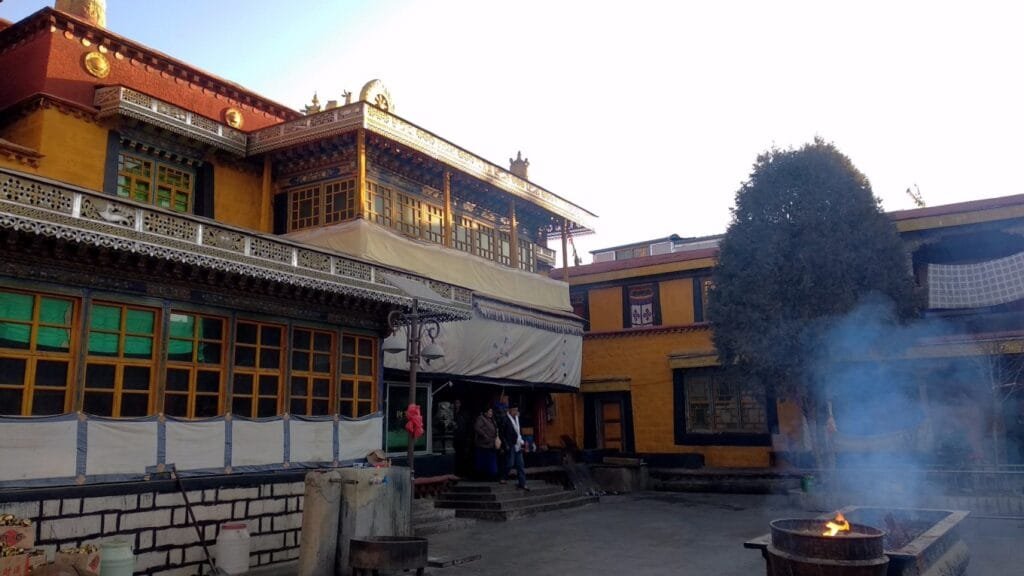
The monks of Drachi Temple recite scriptures that are similar to those of other Geluk sects’ temples, including Sera Monastery. However, the temple is particularly known for Drachi Lhamo’s ability to fulfil worldly desires, making it a popular destination for those seeking blessings. Visitors can provide the names of loved ones to the monks, who will recite scriptures and offer appropriate guidance.
Upon entering the temple, visitors can participate in a standard Buddha ceremony. A wooden box filled with coins is available for donation, one can exchange the 10 yuan note for 100 notes of cents. Visitors can either count the coins themselves or seek assistance from an available attendant.

Guru Padmasambhava Chapel
After paying homage to the Buddha, you ascend a steep staircase adorned with Tibetan features on the left side of the entrance. This leads to the second level, where you can prostrate before two Buddhist temples consecutively. Then, descending another steep staircase takes you to the actual main hall of Drachi Temple.
In Guru Temple, statues of Buddha Shakyamuni and bodhisattvas are present, along with a woodcut rendition of Kangyur and Tengyur inscribed in gold ink among other items. Visitors often stoop and walk beneath these scriptures while meditating on the Manjushri’s Mantra: Om Ara Baza Nadi.
Many students visit Drachi Temple before the national High School examination, seeking help and often achieving exceptional results. After completing the temple’s circuit and passing through the room with large meridian Prayer wheels, visitors typically turn the wheels thrice, seven times, or nine times.
Over 20 years ago, Han people who travelled and conducted business in Lhasa learned that the god of the mainland is also revered in Tibet. Feeling intrigued, they visited Zhaji Temple to pay their respects. Many Chinese believers seek both wealth and fortune, and they frequently visit Taoist temples. Interestingly, businessmen bring liquor offerings to worship at Drachi Lhamo Temple, and they all make a fortune. Word spread quickly, and the temple’s incense offerings became very prosperous.
It’s not just about money, as many students strive for good grades in the middle school entrance exam also visit here every year.
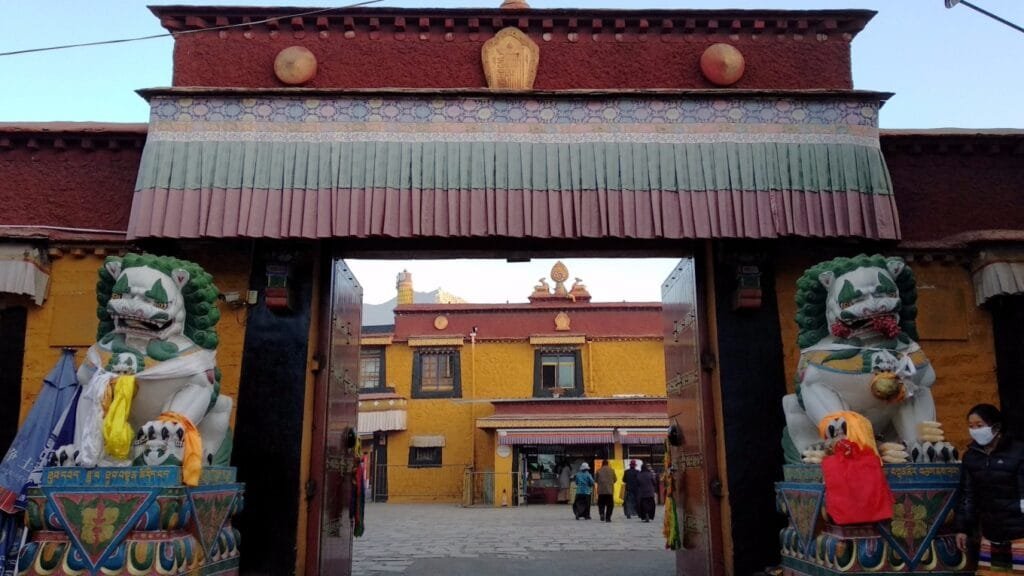
Dachi Lhamo Temple is one of the few temples that doesn’t charge admission, so tourists often visit. Local people line up here every morning, but Wednesday is particularly special because it’s the birthday of His Holiness. Money isn’t everything, but it’s certainly necessary. Drachi Lhamo Temple will truly fulfil the wishes of contemporary needs.


